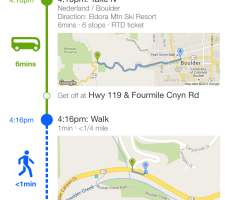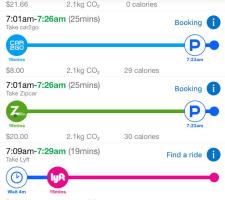
If Mobility-as-a-Service (MaaS) is ever going to work, it needs to have “one universal platform everywhere” according to Sean Mackin, former manager of parking and mobility services at the Denver transportation and mobility department and now Colorado branch manager for ABM Parking & Transportation.
Speaking at the recent
Yes, agreed fellow panellist Hans Arby, chief executive of UbiGo, but forcing the issue won’t work. “We need proper standards … that will be the way to bring about unification.”
Using enforcement and compliance penalties “would be like saying to every country in the world that they must have the same economy and the same outlook,” Arby added. “It would be very hard to bring about. In fact, probably the only country where it would work would be North Korea … or maybe Russia.”
In Mackin’s previous job in the Denver transportation and mobility department, he played a leading role in the launch of the Go Denver mobility project and remains very keen to see the MaaS concept move forward.
He and Arby both agree that MaaS needs legislation to bring about a standardised way to resell public transport tickets. It needs “new pricing models to simplify the offering” and the industry needs to “see more innovation in public transport thinking.”
All in all, said Arby, “we need to capture more value to prove that this [MaaS] idea could be a really good business for everyone involved.”
New Mobility
Mackin became a convert to the cause in February 2016 when the city and the county of Denver joined forces with
The city is one of America’s fastest-growing urban centres and, when the Go Denver app was unveiled, mayor Michael Hancock said that his team wanted to help “residents and tourists find the cheapest, fastest and greenest way to move about the city.”
Users download a simple app to their smartphones and put in their destination and desired arrival time. Go Denver quickly calculates the different routes available and sorts them as ‘sooner’, ‘cheaper’ and ‘greener’.
When the system was launched Xerox said the app “aggregates and calculates the time, cost, carbon footprint, and health benefits from walking, biking, driving, parking and taking public transit”. It also assesses a variety of ride-hailing options – such as Lyft,
Denver is a great place to try out a scheme like this, Mackin told the ITS International-organised conference in London. “Greater Denver has a population of about 2.5million, it’s full of millennials and we’re experiencing our biggest population growth rate since the gold rush.”
The trouble is, the population might be expanding fast, but the city’s road network isn’t. “Lots of our city centre parking lots have been developed since the 1970s and 1980s,” said Mackin, “and our zoning policies have changed.” Denver is rapidly running out of space.
“Our first challenge was which app to choose. They are all out there.” Denver went with Xerox Mackin told the conference, because “we had a relationship and sense of trust with them. They had this app and they needed a test sponsor. It was perfect timing” and a perfect match. Los Angeles soon followed suit and became the second test city for the app.
Popular launch
Launched last year, Denver’s project has proved popular, not least because it can recommend and highlight personalised commuting options as it learns more about the user’s individual travel preferences. Users can also save trips they take often in the ‘My Rides’ section of the app. Today, more than 7,000 users are registered on the Go Denver platform.
The next version of the app will integrate bookings and payments so that users can plan their entire trip with a single click of a button, says Conduent. There is also a ridesharing angle to the system, so that users can carpool with people who are traveling in the same direction, as well as destination parking information. Users will eventually be able to create a profile where they can set goals related to their personal fitness, financials and time and track these within the app.
All this real-time data is gold-dust too. “It is all about providing the city with better analytics,” says Mackin. “That was one of the main reasons for choosing Xerox. We knew that they could enable better data-driven decisions in a lean management system.” What’s not to like?
Data Benefit
Conduent (or Xerox as it was) wants to continue championing the growth of MaaS and the data it can feed back into the world’s big urban transportation authorities. In a major piece of new research commissioned by the company in the autumn of last year, it was revealed that ‘by 2020, half of citizens believe that they will use only one transportation app and more than a quarter will use a self-driving car.’
Indeed, she added, “the Go app captures the universe of transportation options available in a city and computes the quickest, cheapest and most sustainable way to reach a destination. Offering sophisticated apps, such as Go Denver, opens the door for behaviour change among citizens.
“Even though younger generations are more apt to use public transit, older generations still prefer cars. These types of apps are a great way to get all citizens on board with using alternative modes of transportation, which will ultimately reduce congestion within the city and allow for existing infrastructure to be used more efficiently.”
Wider coverage
Interestingly, trip planning has not been limited to the immediate downtown area of Denver either. To get the efficiency improvements that the partners are seeking, the app was built to cover a wide swathe of the Denver Metro and Boulder Metro areas including outlying towns such as Aurora, Lakewood, Centennial, Littleton, Arvada, Westminster, Thornton, Longmont, Allenspark, Jamestown, Altona, Hygiene, Gold Hill, Erie, Dacono, Fort Lupton, Lafayette, Louisville, Superior, Eldorado Springs, Coral Creek, Rollinsville, Henderson, Lochbuie, Golden, Blackhawk, Genesee, Morrison, Evergreen, Indian Hills, Lone Tree and Parker.
And, in another move to keep the users in a positive frame of mind, the Go Denver team work hard to inform people that “the data generated is completely anonymous, so the city will not be able to track where someone is or learn exactly where they’ve been or are going. The city will receive data such as: frequent destinations, most used modes of transportation and peak travel times.”
It’s all about “getting the first mile and the last mile right” says Mackin. It’s about being where you need to be. “That is very, very important.” And 7,000 users can’t all be wrong.








